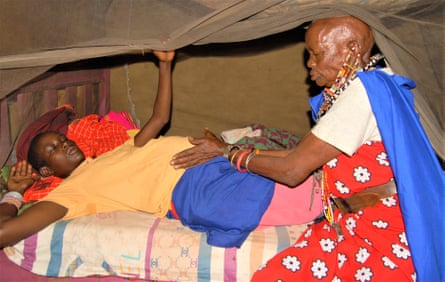Good morning. Yesterday afternoon, a private jet crashed in the Tver region near Moscow, killing all 10 passengers on board. Among them, according to Russian authorities, was Yevgeny Prigozhin, the Wagner paramilitary chief who launched an armed mutiny in June. For the latest on his dramatic yet somehow unsurprising death, visit our live blog.
For today, I’ll be looking at a very different story, the UK’s first ever womb transplant. It’s been hailed as a fertility landmark and the dawn of a new era, offering dozens of infertile women the chance to have babies every year. The recipient was a woman born without a womb; the donor was her elder sister, who already has two children.
Organ donation is a very precise science. Though the law changed in 2020 so that all adults are automatically assumed to be organ donors unless they opt out, only 1% of all people who die in the UK every year are eligible for their organs to be used to save someone’s life. Living donors, like the sister in this story, now make up 40% of donors in the UK, putting their own health at risk for an act of altruism.
I’ve spoken to Adam Balen, professor of reproductive medicine and surgery at Leeds teaching hospitals NHS trust, who has a patient on the waiting list for a womb transplant. He explains why the operation is so tricky, and sets out the obstacles to broadening such surgery out to men and transgender women.
In depth: ‘It’s an alternative to surrogacy for women wishing to carry their own babies’

The 34-year-old woman receiving the womb (also known as a uterus) was born with Mayer-Rokitansky-Küster-Hauser syndrome (MRKH), a rare condition affecting about one in every 5,000 women. Her 40-year-old sister offered to donate her womb after completing her own family.
The transplant took place in February, at the Oxford transplant centre, but the surgeons only went public with the news on Wednesday, after details were published in an obstetrics and gynaecology journal and doctors were able to report both patients were recovering well.
The surgery took nine hours and 20 minutes and the woman will need to take immunosuppressant drugs throughout any future pregnancy to prevent her body rejecting the donor organ, with the transplant expected to last a maximum of five years before the womb is removed.
Uterine transplantations have been carried out in more than 90 cases internationally over the past 10 years, with most involving a living donor. About 50 babies have been born as a result. The team in Oxford practised the procedure on animals first, including rabbits, pigs and sheep.
Balen, who runs a clinic for girls born with congenital abnormalities such as the absence of a uterus, sees the procedure “as an alternative to surrogacy for women wishing to carry their own babies”. The first ever procedure was pioneered in Sweden in 2013, where surrogacy is illegal, he said.
What happens next?
The ultimate test will be whether the recipient can get pregnant and carry a baby to full term in her new womb. She underwent IVF before the operation, using her own eggs (she was born with ovaries, just no womb), and hopes to have the resulting embryos implanted in her donated womb soon.
She has since had three periods, which doctors see as a positive sign that her reproductive system is functioning well.
If she does get pregnant, the baby will need to be delivered by caesarean section, according to Balen. “The transplanted uterus is usually removed after the family is complete to avoid the prolonged use of anti-rejection medication,” he said.
Does this open the door for men or trans women to carry babies?

To date, only biologically female recipients have been used in animal and human trials of uterine transplant, and Balen thinks transplants for men or trans women is “still a little way off”. Some scientists think it will one day be possible for someone born male to carry a child in a donated womb, but there are plenty of biological hurdles to overcome first.
The main one, says Balen, is the male pelvis, which is not designed to carry a baby. The other difficulty with a womb transplant is what he calls the “plumbing”. Someone born without a womb will also be missing the necessary uterine vessels, which carry blood to the uterus. It is the reason the UK woman at the centre of this story had to have her donated womb connected to blood vessels in her legs, says Balen.
What does this mean for transplant technology?
Uterine transplants will probably become more common, though experts expect this could be limited to a maximum of 30 UK operations each year due to a shortage of donors.
READ RELATED: What It’s Like to Live With Hemiplegic Migraine, the Neurological Disease That Looks Like a Stroke
Having your uterus removed – a hysterectomy – is a big operation that can prompt early menopause. There are a number of different reasons to have the procedure and a small survey of trans men who had undergone a hysterectomy as part of gender-affirming surgery found that 88% would be willing to donate their wombs.
Transplant technology is developing rapidly in the UK. Last year, the country’s first sternum transplant took place, with the chest wall of a dead woman being implanted in 34-year-old Nathalie Brett, who was diagnosed with metastatic (stage four) breast cancer.
A corneal transplant is the most frequently performed transplant surgery in the UK, with 3,529 operations last year. This is despite corneas being the part of the body that most people specifically chose not to donate after death, with one in 10 people on the NHS Organ Donor Register making that request. For the squeamish: the NHS says that it never takes full eyes, just corneas, and the procedure can be done without delaying a funeral or the donor looking any different.
Balen is excited about the future of transplants, saying the Oxford success story “opens the door” for more women to carry their own babies.
after newsletter promotion
What else we’ve been reading

-
Girl dinner? Normcore? Bed rotting? These aren’t random words but trends taking the internet by storm. Arwa Mahdawi pithily lets us know how we can capture the zeitgeist by turning the most banal concept into our very own micro-fads. Nimo
-
Anita Chaudhuri visits New Ground, Britain’s first co-housing community exclusively for women over 50 (pictured above). Is it a trailblazer for a society in which ever more older people are living alone? Helen
-
ICYMI: Ronan Farrow’s New Yorker (£) deep dive into Elon Musk’s ever expanding ties with the US government is a must read. Farrow explores how politicians who became reliant on the tech billionaire are now struggling to keep him in check. Nimo
-
Recently there’s been a glut of first-person reports from electric car owners struggling to find EV charging points, so it is refreshing to read Charlotte Naughton’s dispatch from a trip to Ireland where nothing went wrong. Helen
-
Summer is on its way out but ice-cream is a treat that we should all enjoy year-round. Felicity Cloake sets out the perfect recipe to make strawberry ice-cream at home – no fancy machines required. Nimo
The front pages

“Wagner chief Prigozhin reported dead after jet crash near Moscow” is the top story in the Guardian print edition. Thursday’s Financial Times has “Wagner boss Prigozhin was aboard crashed plane, say Russian officials” while the i says “Putin critic killed 60 days after mutiny”. “Putin’s revenge” says the Sun, while also calling it a “riddle”. The Daily Mirror also uses “Putin’s revenge” while the Daily Mail poses the question: “Was this Putin’s terrible revenge?”. “Prigozhin killed in plane crash, says Russia, as allies blame Putin” – that’s the Daily Telegraph while the Times goes with “Wagner boss who crossed Putin ‘killed’ in jet crash”. “No Surprise” – that’s more or less what Joe Biden said and so does the Daily Express, adding “Warlord enemy of Putin ‘dies’ in crash”. Prigozhin gets a little mention on the front of the Metro – the story’s inside – while its lead is “India over the moon” after the landing of its spacecraft.
Today in Focus

Cotton Capital: Reparations – episode 6
Revisited: In the final episode of the series, Cotton Capital editor and Guardian journalist Maya Wolfe-Robinson looks at the subject of reparations. What do they mean for communities and descendants of transatlantic enslavement – and what is the Guardian planning to do in its own programme of measures?
Cartoon of the day | Steve Bell

The Upside

Kenya has one of the world’s highest maternal mortality rates but traditional midwives are helping to make deliveries safer. Their skills and the respect they engender in rural communities are being used to encourage pregnant women to give birth in cleaner, safer local clinics.
According to one nurse, this has led to the number of hospital deliveries to increase by 90% which has led to a reduction in child and maternal mortality as well as a decline in the spread of HIV and hepatitis among low-income families.
Sign up here for a weekly roundup of The Upside, sent to you every Sunday
Bored at work?
And finally, the Guardian’s puzzles are here to keep you entertained throughout the day – with plenty more on the Guardian’s Puzzles app for iOS and Android. Until tomorrow.




